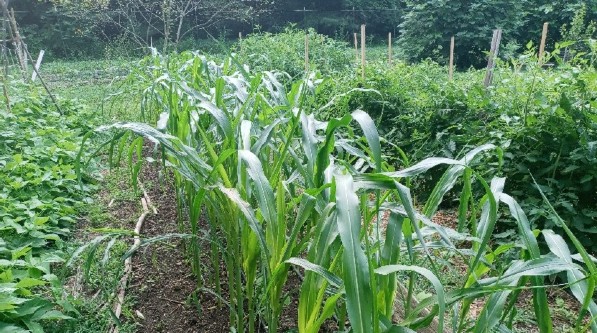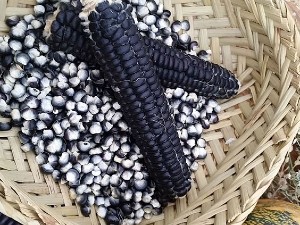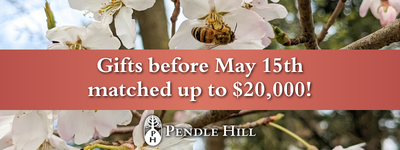Driving through the countryside from Pennsylvania to Oregon, we could see miles and miles of field corn subsidized by our tax dollars, fertilized by chemicals derived from petrochemicals – also subsidized – fed to animals, and seemingly so cheap that the farm lobby fights to put this “food” ironically into our gas tanks as biofuels.
In the garden here at Pendle Hill, less than an acre of space is a precious commodity. Growing a crop such as field corn, which is typically grown by the acre rather than the foot, is not an obvious candidate. So why dedicate two of our long rows to this crop? Given the chance to collaborate with an innovative local seed saver, Owen Taylor of True Love Seeds, recognized in the media by the Philadelphia Inquirer, NPR’s Radio Times, and The Grid magazine, seemed like an opportunity that could be valuable outside of just produce for Pendle Hill’s kitchen.
Owen and True Love Seeds are dedicated to community food sovereignty and the cultural preservation of foods and the seeds from which they are derived. Owen offers an African diaspora seed collection, as well as seeds derived from indigenous cultures, offered free of charge, re-matriating them to tribal members and organizations.

After talking to Owen and mentioning how Pendle Hill had been invested in reconciling Quaker’s history and interactions with indigenous people as well as my interest in growing corn, he suggested Sehsapsing (Oklahoma Delaware Blue) flint corn.
Best described from the online catalog, “Sehsapsing Blue Flint Corn are breathtaking 7-inch cobs of blue kernels that can be ground for flour, grits, and a traditional cornmeal mush called sapan. Sehsapsing Blue corn is an important variety to the Lenape people whose homeland covers what is now New Jersey, Eastern Pennsylvania, Southern New York, and Northern Delaware. William Woys Weaver received seeds of this variety in the 1970’s from both Gladys Tantaquidgeon (Mohegan medicine woman and ethnographer) and Walton Galinat (a Connecticut Yankee who specialized in native corn). The USDA received seeds of this variety in 1985 from Charles Dean, husband of Nora Thompson Dean, a Unami Delaware/Lenape herbalist who dedicated her life to preserving the culture and traditions of her tribe. This variety was brought west to Oklahoma by her mother, Sarah Wilson Thompson. Many Lenape people moved west over hundreds of years, continually pushed onward by white settlers.”
The seeds grown here at Pendle Hill will be sold by True Love Seed with 25% of the proceeds being donated to the Nanticoke, Lenni-Lenape, Tribal Nation Farm Project.

“Sehsapsing Blue Flint Corn are breathtaking 7-inch cobs of blue kernels that can be ground for flour, grits, and a traditional cornmeal mush called sapan.”
When gardening space is limited, we can have the most impact by growing nutrient-dense greens and roots that do a great job in keeping us healthy from a food-is-medicine standpoint. Other obvious choices and garden favorites such as peppers and tomatoes, which pack the flavor wallop, and are just beautiful always make the cut. Carbohydrate and protein staples conventionally are grown on such a scale that a small-time farmer gazing through the prices at a Walmart or Target can be driven to frustration. Nonetheless, I get motivated by the challenge of self-sustainability and maybe a desire to experience the life of farming before mechanization. I have been tempted by a dual-purpose heritage variety of wheat that could be used in floral displays and make a loaf of bread and with such a folksy name as “Red Fife”- how could I refuse? However, after the harvest, drying in storage, thrashing (smashing the seed of stem), winnowing (think big basket and fan to blow away chaff), and then milling, I was ready to bake my bread which was …fair… but not the complete reward I was expecting after all that work! This season I was tempted by the idea of growing flint corn; it could be planted in the same bed as winter squash (the two sisters in the traditional indigenous three sisters planting method, beans would have to be separate for now) – another space saver!
Meeting Owen and getting the opportunity to practice the skill of saving seed as well as experimenting with an exciting new crop is what makes this job more exciting, and I hope the project’s intent and value is something that the whole Pendle Hill community can share and enjoy. I can’t wait to see how the creativity of our kitchen staff will add to this story!
— Brendan Stiteler, Gardener & Grounds Associate



